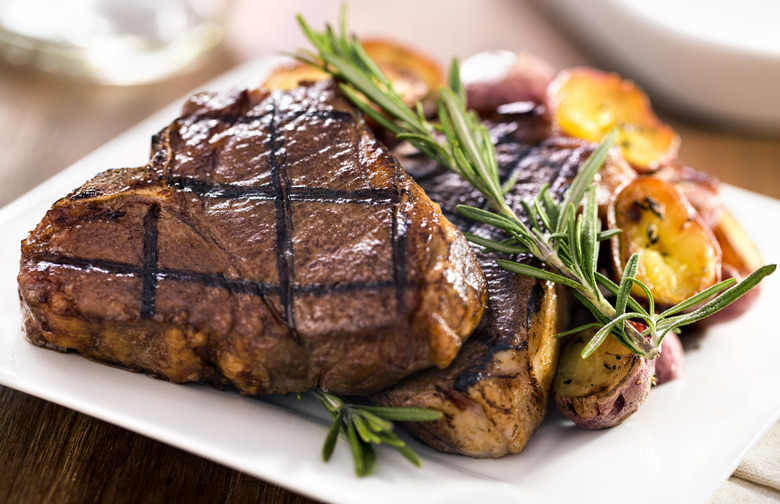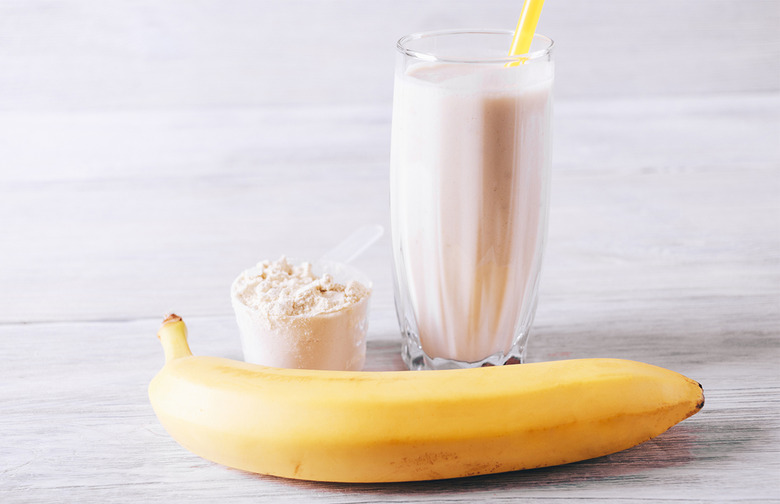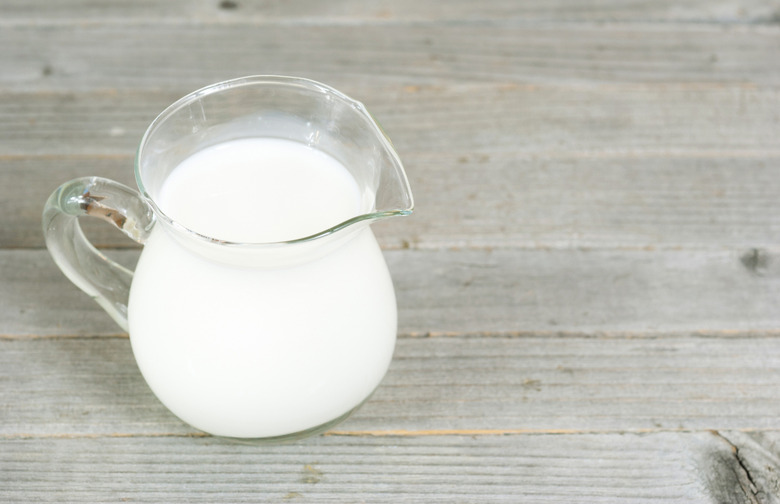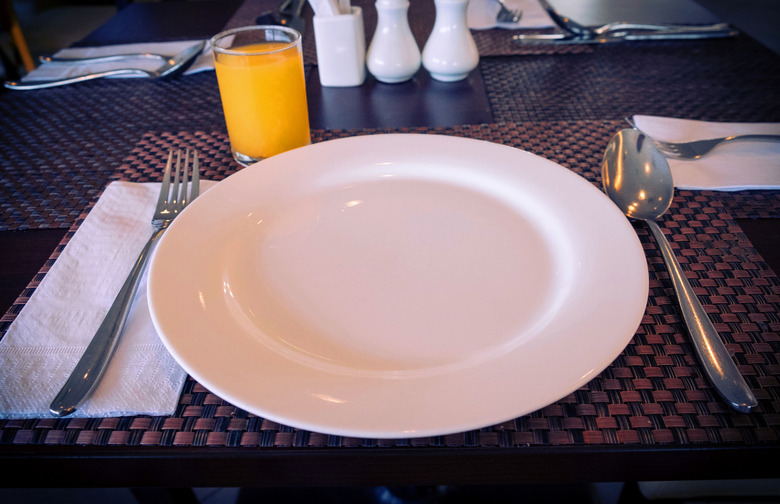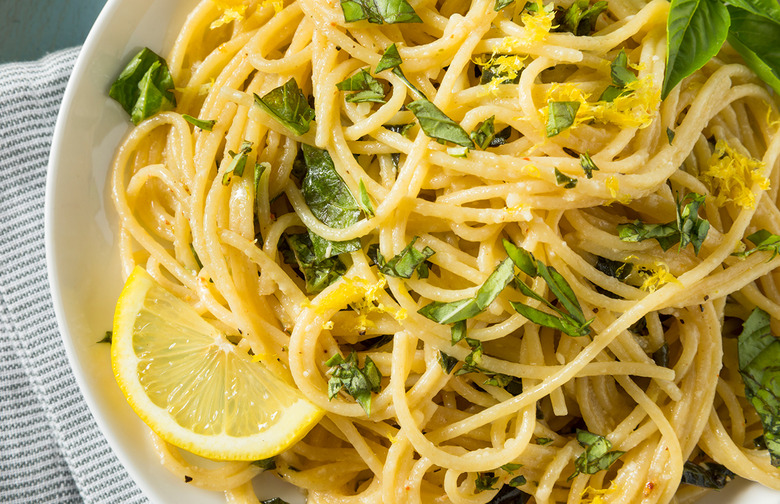Your Parents Probably Tried These Old-School Diet Tips Gallery
We may receive a commission on purchases made from links.
It might be fun to try on your mom's old jeans or brush off your dad's old record player, but we're begging you — leave their rusty old diet tricks in the past. You'll suffer more than just a cold kick of nostalgia if you try to live by any of these old-school food rules.
Back before people knew anything about healthy fats, antioxidants, or protein, people were really just stumbling blindly through unsubstantiated diet advice and weight loss tips. Though many of the diet regimens on this list were endorsed by doctors and "experts," few (if any) were supported by science or evidence.
But that didn't stop people from attempting these wacky fads and trends. Have you ever heard of the "sexy pineapple diet"? What about the diet where you can eat as much sugar as you want? (That one actually doesn't sound half bad...)
From the "cabbage soup diet" to strict detox cleanses, people tried anything and everything they could to shed weight as quickly as possible. Here are some of the most popular (though often misguided) weight loss tips from your parents' dieting days.
Smoking
Though this diet tip died decades too late, its followers shaved years off of their lives trying to replace food and nourishment with something they thought might be healthier: cigarettes. Ads for Lucky Strike cigarettes sold slogans such as "Reach for a Lucky instead of a sweet!" and inspired other brands to follow suit. Stanford University has a website dedicated to collecting an archive of all the cigarette ads that claimed smoking "keeps you slim." Soon enough, people were chowing down on a (not so) healthy breakfast of cigarettes and black coffee instead of a metabolism-boosting morning meal. Delicious!
Lots of Meat
Nowadays, people are woke to the potential risks of eating too much red meat and pork. But back then, meat was considered a healthful, wholesome staple. Cholesterol, who? The emphasis on meat consumption really kicked into gear in the 1930s, when books like Meat for Every Occasion: A Collection of Tested Recipes and Pertinent Facts About the Value of Meat in the Diet were on store shelves. Really? Meat for every occasion? No one but Ron Swanson could approve this plan.
Banana and Milk Diet
This diet was doctor-approved circa 1934, when a doctor from Johns Hopkins University developed the regimen as a treatment for diabetes. Now, it's more of a fad diet, though people still try it here and there when they're trying to lose weight fast. The diet prescribes a daily intake of four to six bananas and three to four glasses of milk for two weeks. After you're sufficiently starved on nothing but carbs and milk fat, the diet instructs that for an additional two weeks, you consume nothing but animal proteins and vegetables. No fats or carbohydrates are allowed. You repeat this four-week cycle until you've lost the desired amount of weight — or slipped on a banana peel and fallen off the wagon.
High-Sugar Diet
In the modern days of sugar cleanses and warnings off of sweets, a sugar-based diet might sound totally bonkers. But in the '50s, sugar wasn't the enemy — fat was. Domino, the company that still dominates the sugar market to this day, ran an advertisement in a 1955 issue of Time magazine that claimed sugar was an integral part of a smart plan to lose weight. "'Sugar-starved' people often lose pep and energy instead of weight!" it warned. "Which is less fattening? 3 teaspoons of Domino Sugar actually contain fewer calories than 1 medium apple!"
The Prayer Diet
One of the most popular diets of the 1950s was called "the prayer diet," and its main tenet was — you guessed it — praying your weight away. After successfully losing 100 pounds, Reverend Charlie Shedd wrote and published a book called Pray Your Weight Away in 1957 and it quickly became a bestseller.
Cabbage Soup Diet
The true origins of this diet remain unclear, but it first earned fame in the 1960s. The diet involves eating large volumes of questionably-appetizing cabbage soup — and not much else. Despite how unsatisfying it sounds, the regimen was famously used by celebrities, models, and women everywhere desirous of shedding quick pounds. Finally in 1997, a book was released detailing the "science" behind the decades-old fad diet. The Cabbage Soup Diet claimed its plan was "the safe, quick weight-loss diet everyone's talking about" and promised to help you lose "up to 10 pounds in 7 days." None of this advice seems sustainable, however, and there is little to no evidence that these claims are true.
Meal Replacement Shakes
In the early '60s, people shied away from the "fattening" horror of eating food and sipped on calorie-dense meal replacement "shakes" instead. There were dozens of brands that sold the products, including Sears' "Bal-Cal" and Quaker Oats' "Quota," according to a Time article from 1960. When Carnation realized people were using their powdered Instant Breakfast as a meal replacement to lose weight, they rebranded the product as "Slender" and sold it as a diet food. The liquid meals amounted anywhere from 250 to 900 calories each — these dieters could have consumed fewer calories eating fast food.
Drinking Safflower Oil
Before low-fat diets were all the rage, dieters sipped straight-up oil to try and lose weight. Dr. Herman Taller recommended sipping it by the glassful in his bestselling book Calories Don't Count, published in 1961. At least 3 ounces was consumed alongside every meal — if you could manage to choke down food after you'd slurped the stuff. Taller was generous enough to sell safflower oil capsules under his personal brand for those who couldn't stomach it. The book became a success, selling over 2 million copies. Taller ran into trouble because of his shady business practices, however; he was indicted in 1967 for mail fraud, conspiracy, and violating regulations set forth by the Food and Drug Administration.
The Drinking Man’s Diet
Liquid lunch, anyone? The 1964 pamphlet The Drinking Man's Diet touted a weight-loss method that involved drinking as much alcohol as you want and almost zero carbs otherwise. The booklet advertised the diet as the best way "to lose weight with a minimum of willpower," which sounds accurate — so long as you don't drunkenly decide to eat an entire plate of nachos at the bar. The regimen was "also recommended for teetotalers," which is confusing. But contrary to the modern opinion, the Drinking Man's Diet characterized alcohol calories as "good calories," while all other calories from food were "bad." If you've ever tried drinking on an empty stomach, you know why this diet is a bad idea.
The Stillman Diet
Karen Carpenter famously began her deadly dieting spiral with the Stillman diet, a diet focused on carb-restriction similar to today's Atkins diet. Other than lean proteins and vegetables, the diet advocates for you to go heavy on spices such as salt, pepper, and herbs, and load up on hot sauce. Other condiments on the other hand, such as ketchup or mayo, were forbidden. The weight-reduction plan was created by physician Irwin Maxwell Stillman in 1967 with the release of his book. The book advocates for eating six small meals a day, rather than three larger ones.
The Buttermilk Diet
What's more slimming than full-fat dairy? Well, pretty much anything... But 1960s America didn't know that. To avoid getting chunky, dieters followed the buttermilk diet, wherein they consumed six full glasses of buttermilk each day. This diet was also advocated for by the ever-trustworthy Irwin Maxwell Stillman. It's not nice to speak ill of the dead, so we won't. But pass your own judgement on this family doctor's "professional" weight loss advice.
The Sexy Pineapple Diet
In 1970, a book titled The Sexy Pineapple Diet was released by Danish psychologist, sexologist, and author Sten Hegeler and his wife Inge Hegeler, the same authors as another bestselling book, The Abz of Love. To participate in the diet, you simply choose two days a week to eat nothing but pineapples. The rest of your days are free for you to eat whatever you want and enjoy your new bod, which the book claims will be "slim and erogetic." (No, "erogetic" is not a word.) Along with weight loss, the Hegelers promise the diet will deliver you increased energy and "sexual capacity." Chicago Tribune writer Alice Cromie said in a review that the diet "guarantees 24-hour dismay." Cromie's review details the odd interior of the book, which is allegedly filled with illustrations of pineapples, women next to pineapples, and for "a surprise finish — five hamburger patties in a fry pan."
Diet Pills
People were notoriously reckless with drugs in the '60s and '70s, and dieters were no exception. Diet pills skyrocketed in popularity during these decades, usually made up of indigestible starches and fibers that left dieters doubling over in abdominal pain. Some treatments were even more dangerous, however. Dexatrim was famously outed for increasing its users' risk of stroke, while other methods were based on dangerous stimulants and the drug now known as Adderall. Despite the dangers, millions of women tried diet pills before they were removed from the shelves.
The Israeli Army Diet
This odd but surprisingly popular 1970s-era diet has nothing at all to do with the Israeli Army — though it does require some soldiering through. The Israeli Army Diet is an eight-day trudge during which you're only allowed one type of food per day. On days one and two, you eat only apples. Three and four you eat cheese, after which you eat two days of chicken and two days of salad. All those foods are fine and good, but wouldn't you rather eat a nutritious meal that includes all of them? This apple chicken salad should do the trick.
Grapefruit Diet
The classic "grapefruit diet" was invented in the 1930s, though it didn't really gain any traction until the 1970s. The diet involves eating a grapefruit with every meal — not a terribly dangerous idea, though it doesn't make much actual sense. The idea was that grapefruits contain an enzyme that has the power to actually burn fat as you eat it. This has since been disproven.
Starve Yourself
Unfortunately, the most tried (though not true) method of dieting is simple: starvation. People have been trying to starve themselves thin for as long as many can remember, despite how dangerous and unsustainable this method is. Still, it's been supported by diet books and gained an especially high level of popularity after The Beautiful People's Diet Book was released in 1973. "For heightened perception without drugs plus rapid weight loss, nothing beats the oldest known treatment for obesity: total starvation," it read. Excuse us while we cringe.
Cookie Diet
In what might have been a thinly veiled plot to sell as many of his "specially formulated" cookies as possible, physician Sanford Siegal popularized the "cookie diet" in 1975, which claimed to help you lose weight if you ate one or two of Siegal's cookies every couple of hours to stave off hunger. Other than the cookies, dieters were only allowed a 500-to-700-calorie dinner.
Master Cleanse
The Master Cleanse is perhaps one of the most dangerous diets to hold up over the years — people still reportedly try the diet to lose weight today. Even Beyoncé tried it! But the regimen got its start in 1976 with the release of The Master Cleanser by Stanley Boroughs. It involves a liquid-only diet, with a blend of lemon juice, cayenne pepper, and maple syrup as the only concoction you're allowed to consume. Some modern iterations leniently allow salt water and herbal laxative tea, as well. There's nothing safe or smart about this diet, so dear God, do not try it. Leave this "detox" diet in the '70s where it belongs.
High-Carb, Low-Fat Diets
What diet involves eating as much pasta and bread as your heart desires? Certainly not today's keto diet — but in the 1970s, carbs were all the rage. Even government recommendations permitted the liberal consumption of carbs. The kicker was that you just couldn't eat any fat with them. (Sorry, no Alfredo allowed.) Studies have since proved this advice to be misguided, but dietary recommendations advised Americans and Brits eat fewer than 10 percent of their calories from saturated fats, while cautions about sugar and carbs were wholly neglected.
The Scarsdale Diet
Herman Tarnower was a practicing cardiologist when he published The Scarsdale Diet in 1979, a book which advocated eating under 1,000 calories per day in the name of weight loss. We're not sure what's scarier: That calorie count or the fact that the book exploded in popularity when Tarnower was murdered by his lover Jean Harris in 1980.
Ayds Diet Candy
The unfortunately-titled Ayds diet candies were wildly popular appetite suppressants in the late '70s and early '80s. They came in chocolate, caramel, and butterscotch flavors. One of the main ingredients was phenylpropanolamine, a stimulant used on dogs to control bladder problems. It's outlawed in Canada and can cause excessive sweating, drying up of mucus glands, and even strokes. The product was forced off the shelves in the mid-1980s when the AIDS crisis gained media attention. "Why take diet pills when you can enjoy Ayds?" their ads recited.
Trick Your Man Into Losing Weight
"Here at last is the book which shows how, using stealth, subterfuge, trick and treat, you can painlessly save the man you love from unsightly and unhealthy pounds," advertised the description of a popular 1980s diet book, How to Take 20 Pounds Off Your Man. Apparently, the sly tactics detailed in this book were subtle enough to melt pounds off your hubby without him even noticing. The cover claims you can really "surprise him with a svelte new body — his!" What man wouldn't love that?
Eat Like Elizabeth Taylor
Who doesn't want to look like Elizabeth Taylor? (Well, what she looked like in the '80s at least...) When people discovered in the late '80s that the British-American actress released her diet tips and tricks in her book, Elizabeth Takes Off, everyone and their mother started trying to eat just like Elizabeth Taylor in the hopes that they, too, might look like they belonged on the big screen. Taylor's tips included mixing cottage cheese with sour cream, shoving a slice of steak in the middle of a peanut butter sandwich, and sipping mimosas for breakfast. Before you scoff, remember that people still look to celebrities for their diet advice — no matter how wacky their habits.
More from The Daily Meal:
The Most Popular Diets of Every Decade Since 1900
Surprising Reasons You Should Eat More Fat
What the World's Oldest People Eat (or Ate) Every Day


